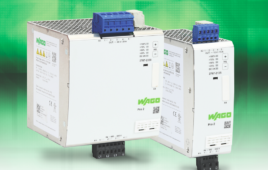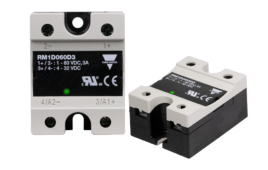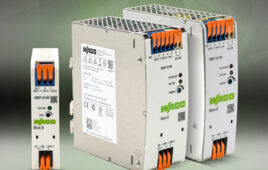Several manufacturers are now exploring molded plastic and other odd-ball substrates for circuits as a way to simplify product designs and cut costs.
Leland Teschler | Executive Editor
If you looked inside a smoke detector designed by a Swiss company called Multiple Dimensions AG, you might at first be a little confused. You’d find the usual 9-V battery, smoke sensor, and test switch, but no wiring or circuit board connecting the components together.

The conventional smoke detector, top, and a version redesigned by the Swiss firm Multiple Dimensions AG, bottom. Conducting traces are applied directly to the molded part. One notable option available via molded interconnect methods is that a capacitive switch can be integrated into the circuit to replace the previously-used mechanical switch.
The point of molded interconnect techniques is to eliminate the need for a separate printed circuit board (PCB). Eliminating the PCB is obviously advantageous for structural simplification and reducing the number of parts. Manufacturers say that when volumes are high, the economics can be compelling.
Molded interconnects have been around in various forms for years. But they have tended to be used in niche products rather than in the main stream. “A lack of volume manufacturing is one reason molded interconnect technology hasn’t caught on. But what appears to be happening now is that manufacturing costs are going down and there is a pressure to deliver on form, fit, and reduced weight,” says David Wiens, product marketing manager at the Board Systems Div. of Mentor Graphics, a Siemens Business.
Mentor is well positioned to have a bird’s eye view of interconnect work: It provides both PCB design and MCAD software products. Wiens says Mentor has seen interest among design engineers in software tools specifically able to handle the kinds of problems that arise in MID designs.
“We find a lot of engineers working with molded interconnects now use MCAD systems rather than PCB or ECAD systems,” Wiens says. “That means the software has no intelligence about the electronics or how the electronics is built. They are trying to add intelligence about these things to an MCAD structure. Conversely, we have customers doing molded interconnects from the ECAD side, but there are tradeoffs. You must visualize in 3D, but you are still working with a planar board,” Wiens says.
Difficulties may arise when conductors go on substrates selected for their mechanical properties as in MIDs. One potential problem is that materials can change consistency when they go through a molding process. The changing parameters can affect the electrical qualities of conductors deposited on top. And putting conductors on mechanical components that bend in complicated geometries can change electrical qualities in ways that may be hard to anticipate. Consequently, the mechanical make-up of molded interconnected parts may be sophisticated, but the electronics sitting on the part tends to be relatively simple.
The complexities of molded interconnects pose problems for CAD systems because a lot of designs get recorded as AutoCad or Gerber files. For one example, ordinary PCB CAD programs can build-in design constraints imposed by specific PCB manufacturing facilities. But there are a disparate variety of processes used to devise MIDs. Consequently, CAD suppliers say it is impractical to create design software able to handle the numerous MID processes now in use.
Sizing up processes
One MID process that has been around since the late 1990s was devised by LPKF in Germany. Called laser direct structuring (LDS), the usual procedure is to injection-mold the part from a special polymer containing organo-metallic substances. Once molded, the part is hit with a laser beam that creates tracks on the surface of the part that will later be turned into conductive traces. These activated areas become metallized in a chemical bath to create the conductors. In a final step, a barrier layer of nickel is applied and then conditioned with a thin layer of gold to ensure good solderability.

Examples of the MID process in use: (Top) Griffith University in Australia worked with Chicago-based technology application consultants Design HMI LLC on an automotive dome light using a process called circuits in plastic (CiP). Center, another dome lamp design using MID technology created by Harting SA. Bottom, a capacitive touch sensor integrated into the MID dome light. The overall MID dome Lamp design came from OSRAM, Microchip Electronics, IEE SA, and Harting SA.
It’s possible to create two-sided boards with LDS. To do this, the part must have vias, as with ordinary PCBs, but the vias must be conical on one or both sides depending on the thickness of the material. The internal diameters of the vias must be large enough to ensure unimpeded processing by the laser beam.
Some manufacturers that employ LDS report success using even more stringent design rules. Multiple Dimensions AG, for example, says it gets trace widths down to 80 μm with a high yield thanks to its own advanced process development techniques. The smallest part the German manufacturer has produced using LDS is 2×2×0.8 mm.
Multiple Dimensions says it has used several methods to design traces on molded parts. One way is through use of a software package called Target3001 that is specifically designed for 3D-MID functions. But more conventional means are used as well. Frequently, a mechanical engineer makes a projection of the plane where the components will reside from the 3D part model, then exports it as a 2D file. Then electrical engineers import the file and begin the circuit layout. Once complete, the trace design goes back to the mechanical engineer who, in turn, reincorporates it into the 3D CAD file defining the molded part.
Alternatively, Multiple Dimensions may use conventional PCB packages from Mentor, Eagle, or Altium to build up a combination of flexible and rigid PCB surfaces. The design then gets completed on a 3D substrate.
Multiple Dimensions says its rule-of-thumb is that applications involving current below about 1 A are candidates for its MID process, particularly those involving sensing. In one project, Multiple Dimensions used the MID process to create the fingertips of a robotic hand (about the same size as a human hand) with conductive traces. The surface of the robot’s palm is covered with sensors whose pressure signals route to a connector.
Screen printing
Not all molded interconnect techniques use lasers to create traces. An alternative method is to put traces and electronics on molded parts with a process derived from screen printing. That is the point of a collaborative effort among companies that include Sun Chemical Corp., Eastprint Inc., DuraTech Industries, AlSentis LLC, and T+ink.
One goal of the collaborative effort is to more easily field MIDs for user-interface tasks such as control and display panels. Suppliers think MIDs would help pave the way for widespread use of 3D capacitive touch technology resembling that in the iPhone6. As used in iPhones, 3D cap touch incorporates capacitive sensors in a way that let the electronics detect different pressures from the user’s finger. It can also detect multiple touches and calculate the difference in pressure on various points of the screen.

Examples from EastPrint Inc. of screen-printed conductors on molded parts. The center part is printed in the flat with graphic and conductive ink. The part at right is formed and cut. The clear plastic part on the left is the same part that reveals the forming that takes place in the injection mold. The part shown makes up a control panel. The user controls are visible on the reverse side as seen at right in the top image.
PCAP touch screens use a matrix of rows and columns of conductive material, layered on sheets of glass. Voltage applied to this grid creates a uniform electrostatic field. When a conductive object, such as a finger, touches a PCAP panel, it distorts the local electrostatic field at that point. This field interruption is measurable as a change in capacitance. A finger bridging the gap between two of the tracks further interrupts the charge field. The capacitance can be measured at every individual point on the grid. This system can also accurately track touches. The top glass layer of a PCAP brings more sturdiness than resistive touch technology, and it is possible for a PCAP system to sense a passive stylus or gloved finger.
Manufacturers say 3D capacitive touch implemented via MID could find high-volume uses in appliance and automotive applications. Indications are MID-based capacitive touch systems could also be economical in medical devices, portable consumer electronics, and industrial controls.
“Everybody likes capacitive switches better than tactile switches. Capacitive switches made with screen printing techniques are like an advanced version of in-mold labeling,” says Eastprint VP Tom Bianchi.
Eastprint, a long-time maker of membrane switches and electronic front panels, says applications having volumes in the 50,000 to 100,000-piece range are probably fair game for screen-printed MIDs. Bianchi says designs using the technique are largely custom, so design rules can vary from one job to the next. But screen-printed conductors generally can have the same pitch as ordinary printing jobs on polyester substrates. Bianchi also says the usual approach is to screen print electronics before creating the indentations and other geometry that will appear on the mechanical part. “The silver conductive inks are stretchable. Once printed they maintain their conductivity,” he says.
Bianchi says Eastprint uses ordinary flat-bed screen printers to print MIDs – there’s nothing special about the manufacturing equipment. The design rules for circuit artwork tend to depend on the job at hand, Bianchi says. “There are general rules of thumb for how deep we draw conductors and how tight their radius can be, but a lot of that is application dependent.”
Screen printed electronics has one notable advantage over MID techniques involving laser etching: Multilayer circuit boards are practical with screen printing. Bianchi says Eastprint has done circuit designs containing as many as ten layers.

A user control panel screen-printed by Duratech Industries.
Duratech printed electronics development engineer Steve Roellich says the voltages and currents used on screen-printed electronics the company creates generally fall in the 2 to 12 Vdc and 10 to 150 mA range. But he adds that there are variables within conductive ink and trace geometries that can be adjusted to handle higher voltages and currents. Low-end current capacity is generally dictated by trace resistance. Trace resistance depends on trace geometry – length, width, and thickness—as well as the amount of silver loading in the ink and ink curing, he says.
Roellich says Duratech regularly prints circuits comprising three layers and has produced five-layer versions as well. He figures the practical limit on the number of layers has yet to be determined. “We run into printing challenges when we get past three layers. Real estate for routing traces becomes an issue as the number of layers rise,” he says. In the same vein, designs with smaller the trace widths and tighter spacing cost more.
Also important is how the in-mold electronics connect to the outside world. If a molded-in header provides connections, for example, design engineers may need to ensure potential witness marks don’t cause connection problems. Similarly, witness mark location can be important if visible blemishes aren’t acceptable, as in a user interface device.
Because of such considerations, Roellich says design engineers planning in-mold projects should work with printing and molding suppliers that have experience doing in-mold electronics. “The most successful projects I’ve seen start with all the suppliers in the same room working through the part design and manufacture. Each supplier sets expectations for what they can provide.
That helps evaluate factors that bear on manufacturing feasibility such as overall part geometry and the surface geometry of the electronics. You want to make sure the forming of the in-mold electronics applique is within the capabilities of available forming processes. The forming geometry and the mechanical, chemical, and environmental requirements help determine the substrate material.”
You may also like:
Filed Under: Circuits, ELECTRONICS • ELECTRICAL







Tell Us What You Think!